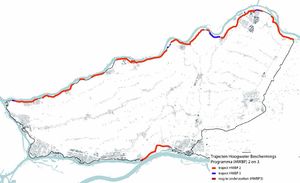Alblasserwaard (NL) - Background
Inhoud
Physical environment and background information
Beschrijving van het gebied (bijvoorbeeld max 400 woorden):
Geografische ligging, stroomgebied, gemeenten, waterlichamen, gebruiksfunctie gebied ...
The Alblasserwaard is a polder to the east of Rotterdam, surrounded by dikes. It is confined by the rivers Lek in the north and Beneden Merwede in the south. Smaller rivers and canals surround the west and the east of the Alblasserwaard. The landscape can be described as a peat-grassland area used for agriculture (Waterschap Rievierenland, 2015). There are several small cities in the south of the polder and linear settlements in the center.
Alblasserwaard consist of ten municipalities called: Alblasserdam, Giessenlanden, Gorinchem, Hardinxveld-Giessendam, Molenwaard, Papendrecht, Sliedrecht, Vianen, Zederik en Leerdam. In the area is a lot of cattle breeding, fruit farming, shipyards and dredging industry. Furthermore, the area has two provincial roads and two highways. In addition, a very busy junction called Knooppunt Gorinchem and one train track is located in Alblasserwaard.
 Frames Pilotbook (2017)
Frames Pilotbook (2017)
Demographics of society
Apply resilience targets: 300.000 inhabitants 2 - 10 communities. Frames Pilotbook (2017)
Flood risk governance arrangement
Apply flood risk governance arrangements according to the following dimensions:
- Diversification and dominance of strategies. Dominance of some strategies and arrangements in this countrie? What factors explain further diversification of flood risk governance arrangements?
- Multi-sector governance. Relates to factors that explain why flood risk governance either has more differentiated structures, such as sector-based water management, or relies on integrated planning – or even integrated risk management – and what are the possible changes therein?
- Multi-actor governance. Concerns factors that explain why flood risk governance is a responsibility of the state, the market and/or civil society, their interrelationships, and possible changes therein.
- Multi-level governance. Relates to factors that explain why flood risk governance is organised locally, regionally, or nationally, what possible shifts in (de)centralisation we see, and how we can explain them.
---------- Alblasserwaard Low diversification, defence dominant. Water sector is dominant. De public (state) is dominant. Central en regional level. Buijs, J-M. (2018)
Challenges for flood resilience
National Adaption Strategy (NAS): The National Waterplan comprises climate adaption strategies to protect the Netherlands from (coastal and river) flooding, to work towards climate resilient urban areas and to ensure adequate supplies of freshwater for generations ahead. The waterplan is implemented by the National Delta programme. How can MLS improve the NAS and local / regional / national activities? The National Water Plan states that the measures required to comply with the updated flood safety standards must be realized before 2050. The National Water Plan's preferred strategy for achieving the flood safety standards is the MLS approach. Buijs, J-M. (2018)
Current situation
References
- Adaptive planning for flood resilient areas: dealing with complexity in decision-making about multilayered flood risk management, Buijs, J-M., Boelens, L., Bormann, H., Restemeyer, B., Terpstra, T., HZ University of Applied Sciences, 1 januari 2018.
- Frames pilots, Interreg, Interreg, 1 april 2017.